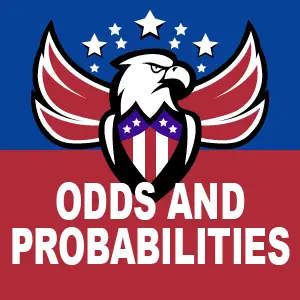Odds and Probabilities

Some people argue that poker is a game of chance rather than skill. They believe predicting the outcome is impossible since the next card is random.
However, calculating odds and probabilities can help “guess” the next card. A few simple formulas, described below, assist in determining card odds. Playing multiple hands reveals that skill is a significant aspect of the game, while luck becomes less important.
Understanding this, poker is indeed a skill game. For serious players, skill dominates luck.
Here are some other related pages and posts:
Probabilities
The formula calculates the frequency of each poker hand, determining the probability of all five-card combinations drawn randomly. Use a full deck of 52 cards, excluding wild cards, to calculate probabilities.
The number 2,598,960 represents poker probabilities, signifying the total number of five-card combinations. Probability equals hand frequency divided by the total five-card hands. To derive odds, use the formula ((1 / p) – 1 : 1), with p representing the probability.
Frequency of five card poker hands
The table below provides precise frequencies. The probabilities and odds are approximate.
| Hand | Frequency | Probability | Odds Against |
|---|---|---|---|
| Straight Flush | 40 | 0.00154 % | 64,973 : 1 |
| Four of a Kind | 624 | 0.0240 % | 4,164 : 1 |
| Full House | 3,744 | 0.144 % | 693 : 1 |
| Flush | 5,108 | 0.197 % | 508 : 1 |
| Straight | 10,200 | 0.392 % | 254 : 1 |
| Three of a Kind | 54,912 | 2.11 % | 46.3 : 1 |
| Two Pair | 123,552 | 4.75 % | 20.0 : 1 |
| One Pair | 1,098,240 | 42.3 % | 1.37 : 1 |
| No Pair | 1,302,540 | 50.1 % | 0.995 : 1 |
| Total | 2,598,960 | 100 % | 0 : 1 |
The table counts the royal flush as a straight flush, achievable in four ways with hearts, spades, clubs, and diamonds. This calculates a probability of 0.000001539077169 and odds of 649,739:1.
Excluding the straight flush and the ace-low straight will reduce their probability, making them nine-tenths less common.
The following page will tell you more about card outs:
Pot odds
To determine the expected value of a play in poker, pot odds are useful. Pot odds help players calculate long-term profitability. Players typically express odds as a win-to-loss ratio and use the following formula to calculate percentage probability:
win : loss odds = win / (win + loss) % probability
For example, 1:4 odds signify a 20% probability (1 / (1 + 4)).
Pot odds can determine the expected value of a poker play, calculating profitability over the long term. Players use them to decide on actions like folding, calling, and raising.
When facing higher pot odds, calling is likely the correct play. Conversely, facing lower pot odds, folding is the best option.
Suppose you can win a $1000 pot with a $1 call. Never fold when pot odds are favorable, as it only requires winning once in every thousand hands.
The winning probability is the chance a player wins with the best hand at showdown. We also consider the possibility that opponents will fold before the showdown.
Be sure to also read:
Pot odds in Texas Hold’em poker
Pot odds calculation in Texas Hold’em Poker is not difficult. To calculate the approximate percentage probability of someone hitting an out on the first card, use the following formula:
(number of outs) x 2 + 1
Suppose you have outs for a flush; the chance of completing your flush with the next card is approximately 19%. There are nine cards to improve your hand, giving 19% odds for one card to come.
With four cards to a flush, nine cards of the same suit remain in the deck. This gives a calculation of 9 x 2 + 1. Therefore, you have an approximate 19% chance of hitting the flush with the next card.
Two more cards remain before the turn and river. You can calculate the approximate percentage probability of completing your hand with two more cards by using the following formula:
(number of outs) x 4 – 1
This means that you’ll have roughly 35% to hit a flush, as there will be two more cards to come. This is the way to calculate the odds with two cards to come: 9 x 4 – 1 = 35% odds.
For a correctly classified action, the odds for winning a hand should never be lower than the applicable pot odds. By consistently doing so, you will be a profitable poker player over the long term.